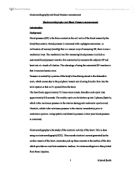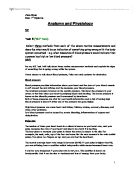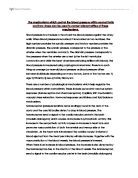Firstly, I assessed the patients knowledge of the procedure, patient X was suffering from Parkinson’s disease dementia, Parkinson’s disease dementia can cause large changes in an individual’s attention and alertness from day to day, one day they are able to hold a conversation and the next day they cannot. I ensured Patient X understood the procedure I was about to perform by explaining each action I was carrying out the whole time. Patient X had been resting in bed for more than 30 minutes so I knew I would get a correct reading. When applying the cuff to her arm I ensured no clothing was underneath the cuff so the arm was not constricted. Patient X was not receiving intravenous therapy, but if she would have been I would have avoided using the arm that had the intravenous cannula or infusion in progress. I then applied the cuff so the centre of the ‘bladder’ was over the brachial artery, 2-3cm above the antecubital fossa. Patient X was extremely stiff which is a common symptom of Parkinson’s disease dementia, which meant she could not lift her arm without assistance, so I tucked her hand under my arm to support the arm whilst I positioned the cuff. The arm should be positioned so that the cuff is level with the heart, to make this more comfortable I rested Patient X’s arm on a pillow. The sphygmomanometer was placed on a firm surface with the dial clearly visible. I then performed a radial check to estimate Patient X’s systolic blood pressure. The radial check allows you to estimate the systolic blood pressure and avoid inflating the cuff unnecessarily high (M. Nicol et al, 2004).
After locating the radial pulse on Patient X, I then squeezed the bulb slowly to inflate the cuff while feeling for her pulse and observing the dial to note the level when the pulse could no longer be felt. Opening the valve fully quickly released the pressure in the cuff. The stethoscope I was going to be using was a communal stethoscope so I had previously ensured the earpieces were clean by using alcohol-impregnated wipes to clean them. After placing the earpieces into my ears I then checked that the tubes of the stethoscope were not twisted and that the stethoscope was turned to the diaphragm side by tapping it with my finger. I then located the brachial artery, which is positioned on the medial aspect of the antecubital fossa (just to the side of the midline on the side nearest to the patient).
After finding the brachial artery I placed the diaphragm of the stethoscope over the artery and held it in place with my thumb whilst my two fingers supported Patient X’s elbow. After ensuring that the valve on the bulb was closed I inflated the cuff to 20-30mmHg above the level I recorded when I performed the radial check to estimate the systolic blood pressure, for Patient X, I pumped the cuff up to 130mmHg as her radial pulse was no longer felt at 100mmHg. Once the cuff was inflated I opened the valve to allow the needle of the dial to drop slowly, approximately 2mm per second. Whilst observing the needle of the dial as it falls I was listening for Korotkoff sounds. The systolic pressure is the level where these are first heard and the diastolic pressure is the level where the sounds disappear. Blood pressure is measured in millimeters of mercury (which is written as mmHg) and it is recorded as two figures: systolic pressure: the pressure of the blood when your heart beats to pump blood out and diastolic pressure: the pressure of the blood when your heart rests in between beats. ().
Patient X’s systolic pressure was 90mmHg and her diastolic pressure was 55mmHg which is classed as a low blood pressure. Individuals who suffer with Parkinson’s disease can experience problems with low blood pressure which is known as hypotension as a result of the symptoms of Parkinson’s and sometimes as a side effect of some of the drugs used to treat the condition. Once the sounds had disappeared, I opened the valve fully to completely deflate the cuff and removed it from Patient X’s arm.
The second stage of Gibbs (1988) model of reflection is the discussion about my thoughts and feelings. I was aware of being under the supervision of two qualified nurses and this made me feel very nervous and self conscious. When I was asked to perform a manual blood pressure on my first patient in practice I felt extremely anxious but also very eager and enthusiastic to perform the skill and to do it well. I had explained to my mentor that I had not performed a manual blood pressure in practice which is why I was asked to carry out one to confirm I was able to do so successfully. Dougherty and Lister (2008) suggest that manual blood pressure monitors are more reliable than their automatic counterparts. Although this is a debatable issue as other authors such as Alexander et al (2006), Endacott et al (2009) and Waugh and Grant (2006) suggest automatic equipment is free from human error. Although human error is possible it is not likely from practitioners that keep up to date with their clinical skills. Whilst on my placement I was asked to use the dinamaps which are the electronic blood pressure monitors. The ward manager preferred the ward staff to use the dinamaps because they were more time sufficient and not prone to mistakes. When taking Patient X’s blood pressure I felt particularly uncomfortable that the two qualified nurses were watching over me, I felt a sense of stupidity as I knew they would be able to carry out a manual blood pressure without thinking twice about it. Although under pressure I felt optimistic about performing a manual blood pressure as I had successfully completed one in university and at home with my own sphygmomanometer.
Evaluation is the third stage of Gibbs (1988) model of reflection which requires reflection on good and bad points about the event. When applying the blood pressure cuff I struggled to do so as Patient X was exceptionally slim and the cuff wouldn’t fit. The nurse suggested I used a paediatric sized cuff which was stored in the clinical store room. I felt as though I should have thought about Patient X’s arm size before I attempted to undergo a manual blood pressure on her. I had to stop and explain to Patient X why I had to take the cuff I had applied off which made me feel very unprofessional and as though I was unsure of my decision in the first place. After applying the correct sized cuff I finished carrying out the manual blood pressure on Patient X which I did so successfully.
Stage four of Gibbs (1988) is an analysis of the event, where Gibbs encourages the reflector to make sense of the situation. The next time I performed a manual blood pressure on a patient I made entirely sure I had the right sized cuff to fit the patients arm accurately.
In conclusion, stage five of the Gibbs (1988) model, my reflection skills have developed through performing the clinical skill in practice and through the production of this essay. When performing a manual blood pressure in the future I will always ensure I have the correct sized cuff to fit the patients arm accurately to avoid disruption, using the Gibbs model of reflection has helped me to structure my thoughts and feelings suitably and has helped me to construct my work efficiently. Being capable to perform a clinical skill in practice which was approved by qualified nurses has made me feel that my professional development is progressing and my awareness of evidence based practice has improved with the use of reflection. As a student nurse I have realised that reflection is essential to learning.
I feel I have learned a great deal from my experience, it has had a considerable effect on my nursing practice. The experience has taught me to always keep high standards of care that are expected and to always be professional and organised when on clinical placements. Whenever I get the chance to use a manual sphygmomanometer when on placement I am always eager to do so to ensure I am developing the skill. I am now much more confident when using the manual equipment and I know I have the ability to perform the skills I require for my future placements.
I am now well aware that I need to put into practice action plans. This is also complemented by the universities action plans and S.W.O.T analysis tools. Action to be taken includes keeping my clinical skills up to date and also pro-actively seeking advice from staff on all clinical placements to ensure I carry out each clinical skill effectively. According to the NMC (2008) you must work with colleagues to monitor the quality of your work and maintain the safety of those in your care. When on placement I must ensure I read clinical placement policies with regard to clinical procedures.
References –
Alexander, M., Fawcett, J. and Runciman, P. (2006). Nursing Practice: Hospital and Home Edinburgh, Scotland: Churchill Livingstone.
Dougherty, L. and Lister, S. Editors. (2008). The Royal Marsden Hospital Manual of Clinical Nursing Procedures (Student Edition) Chinchester, West Sussex: Wiley Blackwell.
Endacott, R., Jevon, P. and Cooper, S. (2009) Clinical Nursing Skills: core and advanced London, Oxford: Oxford University Press.
GIBBS, G. (1988) Learning by Doing: A Guide to Teaching and Learning Methods. Oxford: Further Educational Unit, Oxford Polytechnic.
Hargreaves, J. (1997) Using Patients: exploring the ethical dimension of reflective practice in nurse education Journal of Advanced Nursing, 25 (2), pp. 223-228.
National Health Service (2010). What is blood pressure: How is blood pressure measured? Retrieved from http://www.nhs.uk/chq/pages/what-is-blood-pressure.aspx?categoryid=201&subcategoryid=201
Nicol, M., Bavin, C., Bedford-Turner, S., Cronin, P., & Rawlings-Anderson, K. (2004). Essential Nursing Skills. (2nd ed.). London, United Kingdom: Elsevier Science Limited.
Nursing and Midwifery Council. (2008) The code: Standards of conduct, performance and ethics for nurses and midwives. London, Nursing and Midwifery Council.
Smith, T. (1994). Complete Family Health Encyclopedia. (7th ed.). London, United Kingdom: Dorling Kindersley Limited.
Waugh, A. and Grant, A. (2006). Anatomy and Physiology. London, Churchill Livingstone.








